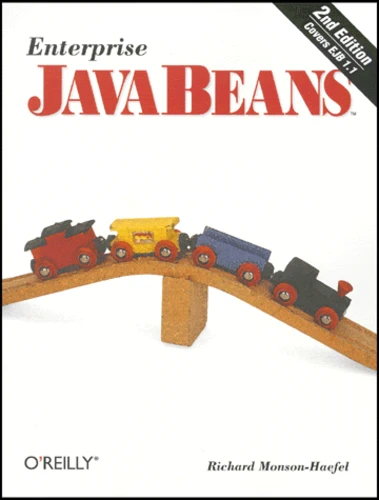Entreprise Javabeans. Second Edition
Par :Formats :
Définitivement indisponible
Cet article ne peut plus être commandé sur notre site (ouvrage épuisé ou plus commercialisé). Il se peut néanmoins que l'éditeur imprime une nouvelle édition de cet ouvrage à l'avenir. Nous vous invitons donc à revenir périodiquement sur notre site.
- Nombre de pages480
- PrésentationBroché
- Poids0.795 kg
- Dimensions18,0 cm × 23,5 cm × 2,5 cm
- ISBN1-56592-869-5
- EAN9781565928695
- Date de parution24/04/2000
- Collectionthe java series
- ÉditeurO'Reilly
Résumé
"Enterprise JavaBeans, Second Edition", is the definitive guide to EJB 1*1, which incorporates the latest developments in EJB technology. Enterprise JavaBeans allows you to build complex, mission-critical systems using snap-together software components that model business objects and processes. EJB greatly simplifies the process of development by taking care of issues like object persistence, security, and transaction management. EJB 1*1 delivers on a promise that was astonishing a few years ago : not only can Enterprise JavaBeans run without modification on any operating system, they could run without modification within any EJB 1*1 enterprise server. EJB 1*0 was a "down payment" that showed portability was possible ; EJB 1*1 goes much further in making server-side components more powerful, portable, and easy to deploy. This book teaches you how to develop Enterprise JavaBeans to model your business and how to use those beans in clients. It covers : Enterprise JavaBeans 1*1 and 1*0. Developing entity beans and session beans. Container- and bean-managed persistence. XML deployment descriptors. The JNDI Enterprise Naming Context (ENC). Transaction management. Design strategies. Bean life cycle. Relationship between EJB and Java 2, Enterprise Edition (J2EE). If you've done any enterprise software development in the past few years, you already know the extent to which EJB bas changed the field. Use this book to catch up on the latest developments. If you're new to enterprise software development, or if you haven't been working with EJB, this book will bring you up to speed on this exciting technology for building business systems.
"Enterprise JavaBeans, Second Edition", is the definitive guide to EJB 1*1, which incorporates the latest developments in EJB technology. Enterprise JavaBeans allows you to build complex, mission-critical systems using snap-together software components that model business objects and processes. EJB greatly simplifies the process of development by taking care of issues like object persistence, security, and transaction management. EJB 1*1 delivers on a promise that was astonishing a few years ago : not only can Enterprise JavaBeans run without modification on any operating system, they could run without modification within any EJB 1*1 enterprise server. EJB 1*0 was a "down payment" that showed portability was possible ; EJB 1*1 goes much further in making server-side components more powerful, portable, and easy to deploy. This book teaches you how to develop Enterprise JavaBeans to model your business and how to use those beans in clients. It covers : Enterprise JavaBeans 1*1 and 1*0. Developing entity beans and session beans. Container- and bean-managed persistence. XML deployment descriptors. The JNDI Enterprise Naming Context (ENC). Transaction management. Design strategies. Bean life cycle. Relationship between EJB and Java 2, Enterprise Edition (J2EE). If you've done any enterprise software development in the past few years, you already know the extent to which EJB bas changed the field. Use this book to catch up on the latest developments. If you're new to enterprise software development, or if you haven't been working with EJB, this book will bring you up to speed on this exciting technology for building business systems.

